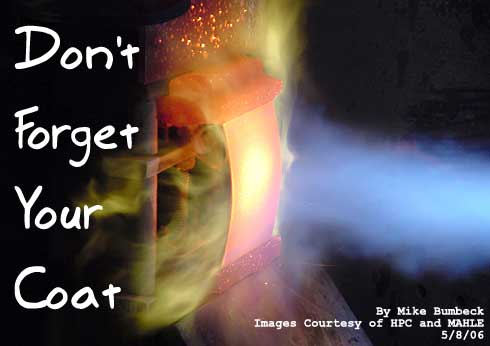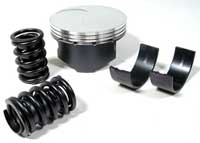
 he aerospace and drag racing worlds may seem disparate, but in fact they are closely meshed. From the time some pioneering individual thought that they could make a lakes racer out of an old P-38 auxiliary fuel belly tank, through the Eighties when drag chassis werereportedly built on the government's dime in close proximity to multi-million dollar jetfighters lined up for repair, right up to the present day when specialized coatings originally purposed to keep things from melting at hypersonic speeds or alive behind an afterburner have made their way into the engines of high zoot racecars. From simple and functional aluminum fittings to exotic coatings able to withstand thousands of degrees in temperature, there can be more aerospace related technology in a racecar than meets the eye. Not that long ago, coatings were the stuff of mystery, best left for those who ran race teams looking for that elusive performance edge. The good news is that the same advancements made from coating parts for rockets to the moon and then proven to work on the ground by big dollar drag racing teams are now available to the average guy racing on a model rocket budget.
he aerospace and drag racing worlds may seem disparate, but in fact they are closely meshed. From the time some pioneering individual thought that they could make a lakes racer out of an old P-38 auxiliary fuel belly tank, through the Eighties when drag chassis werereportedly built on the government's dime in close proximity to multi-million dollar jetfighters lined up for repair, right up to the present day when specialized coatings originally purposed to keep things from melting at hypersonic speeds or alive behind an afterburner have made their way into the engines of high zoot racecars. From simple and functional aluminum fittings to exotic coatings able to withstand thousands of degrees in temperature, there can be more aerospace related technology in a racecar than meets the eye. Not that long ago, coatings were the stuff of mystery, best left for those who ran race teams looking for that elusive performance edge. The good news is that the same advancements made from coating parts for rockets to the moon and then proven to work on the ground by big dollar drag racing teams are now available to the average guy racing on a model rocket budget.
 Bearings and valve springs are another place where the combination of improved oil control and added friction prevention work well together. |
The most obvious benefit of coatings is that of heat control. Head porting guru and ace engine builder Dan Paramore of DPR Racing summed coatings up with one sentence. "They keep heat where it's supposed to be and away from where it's not." The cool part about coatings is the versatility in how they achieve this. The way coatings control heat depends on the type of coating and which part the coating itself is bonded to. On the one side are coatings that control heat by reflecting it. A piston, valve tulip, or the chamber and exhaust port of a cylinder head are some good spots for this type of coating, known as a thermal barrier coating, or TDF.